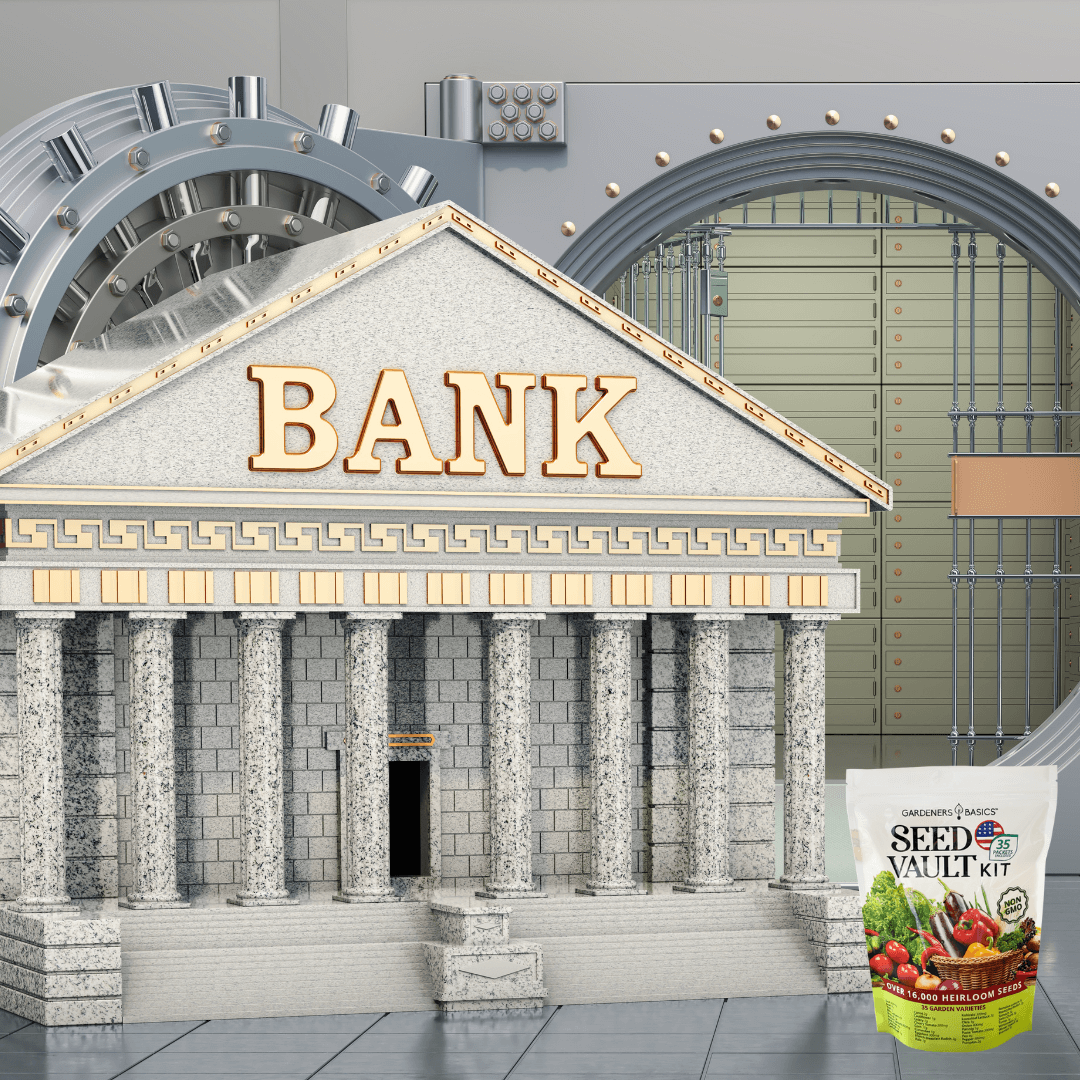Have you ever considered growing a garden that brings beauty to your home and provides food security and self-sufficiency? Survival gardening could be the answer you're looking for! This gardening method allows you to enjoy the freshest produce while becoming more self-reliant. In this informative and practical guide, we'll walk you through creating a flourishing survival garden, from planning and selecting essential crops to maintain your garden and overcoming potential challenges. The price of fresh produce in the store, or even buying plant starts at the store, is just so expensive. Growing your own food provides you with a sense of security and helps you save money.
Planning Your Survival Garden
When planning your survival garden, it's essential to consider factors such as available space, sun exposure, soil quality, and water access. Begin by assessing your garden area and determining the most efficient layout to maximize productivity and accommodate the specific needs of your chosen fruits and vegetables. Select heirloom seed packets that are well-suited to your region and climate, prioritizing nutrient-dense vegetables, high-calorie crops, and herbs that can be easily stored and provide essential nutrients. Incorporate companion planting techniques and plan crop rotation to ensure long-term productivity and maintain soil health. By carefully designing your survival garden, you can create a reliable, sustainable food source that promotes self-sufficiency and resilience in times of crisis or food scarcity.
Emergencies are usually not something that can be seen in advance. Make sure to plan ahead of time. It's a great idea to start growing seeds and making sure you know how to start vegetable plants from seeds before you are stressed and need to feed your family or yourself.
Vegetable Seed Vault Kit | 35 Variety Pack
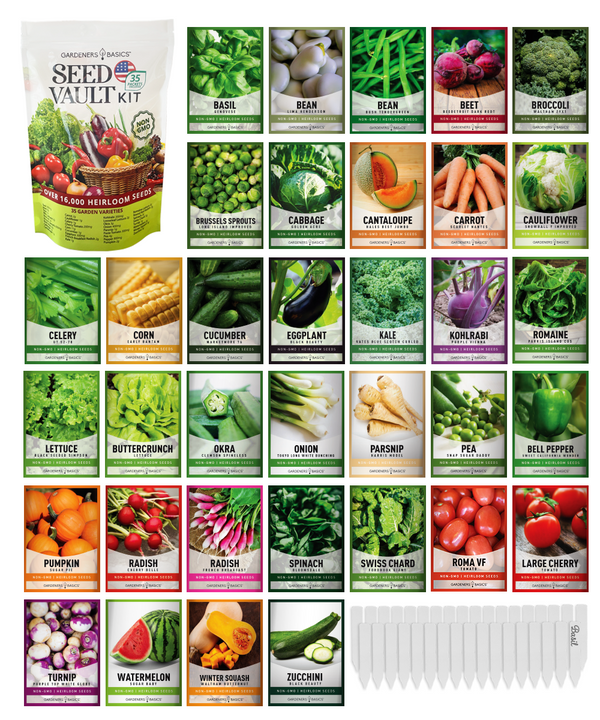
$29.95
$49.95
Ultimate Survival Seed Vault: 16,000+ Non-GMO Heirloom Vegetable Seeds for Emergency Preparedness Introducing the Seed Vault Kit, your all-in-one solution for emergency preparedness and sustainable gardening. This premium seed kit contains over 16,000 non-GMO, Heirloom, Non-Hybrid, and Open Pollinated seeds,… read more
Choosing the Right Location
A productive survival garden begins with selecting the perfect location. Remember that most vegetables need at least six hours of direct sunlight daily. So, choose a spot in your yard that receives plenty of sunshine. Soil quality is also crucial for a bountiful harvest. Conduct a soil test to determine if any amendments are needed to create a nutrient-rich environment for your plants. Lastly, ensure your garden has a reliable water source nearby, as access to water is essential for plant growth.
When planning your garden, it's essential to consider factors like the size and layout of your garden. Assess your family's needs to determine the quantity and variety of crops you'll need to grow. Also, consider space optimization techniques like raised beds, container gardening, or square-foot gardening to maximize your available space. These methods can help you grow more produce in a smaller area, ultimately increasing the efficiency of your survival garden.
Selecting Survival Garden Seeds and Companion Planting
The type of seeds you choose for your survival garden is critical. Opt for heirloom seeds, which produce plants with the same traits as their parents, making seed saving and long-term sustainability possible. We have a large selection of heirloom seeds, vegetable garden seed kits, and survival seed kits already curated for you.
Companion planting your survival garden is another essential aspect of survival gardening. Planting compatible crops together can improve soil health, deter pests, and encourage pollination. For example, tomatoes and basil are a popular companion planting duo, as basil helps repel pests that target tomatoes. Similarly, carrots and onions can be planted together because onions help deter carrot pests. One of the most famous companion planting combinations is the "Three Sisters" method, which involves planting corn, beans, and squash together. The corn supports the beans to climb while the beans fix nitrogen in the soil, and the squash acts as a natural mulch, suppressing weeds and retaining moisture.
Essential Crops for a Survival Garden
In a survival garden, selecting essential crops is crucial in ensuring a reliable and nutrient-dense food supply during times of crisis or food scarcity. When choosing crops, prioritize vegetables high in vitamins and minerals, such as kale, spinach, and broccoli, as well as high-calorie crops like potatoes, corn, and beans, which provide energy and sustenance. Don't forget to include versatile herbs like basil, which offer culinary and medicinal benefits. Opting for heirloom varieties will allow you to save seeds for future planting, ensuring the continuity of your garden and promoting genetic diversity.
When planning your survival garden, consider your chosen crops' adaptability and ease of cultivation. Select plants well-suited to your local climate, soil type, and available space, and prioritize those yield high returns per square foot. Incorporating companion planting techniques and practicing crop rotation can further enhance the productivity and resilience of your garden. By carefully selecting and cultivating essential crops, you can create a bountiful survival garden that is a dependable source of nourishment and self-sufficiency.
Don't forget to grow things you enjoy eating or are willing to eat. You can grow crops to trade with friends and neighbors too or even sell at a local farmers market to get some of your cost for your own food back!
Nutrient-Dense Vegetables, High-Calorie Crops, and Herbs
To build a well-rounded survival garden, include nutrient-dense vegetables, high-calorie crops, herbs, and medicinal plants. Nutrient-dense vegetables like potatoes, sweet potatoes, kale, and spinach provide essential vitamins and minerals to maintain good health. High-calorie crops, such as corn, beans, and squash, offer a significant energy source, ensuring you have the sustenance needed to thrive.
Incorporate herbs and medicinal plants into your survival garden for their culinary and therapeutic benefits. Plants like basil, oregano, echinacea, and chamomile can flavor your meals and provide natural remedies for various ailments. Perennial plants, such as asparagus, rhubarb, and artichokes, are also valuable additions to your garden, as they return year after year, saving you time and effort in replanting.
Seed Safe Survival Seed Kit - 35 Variety Pack
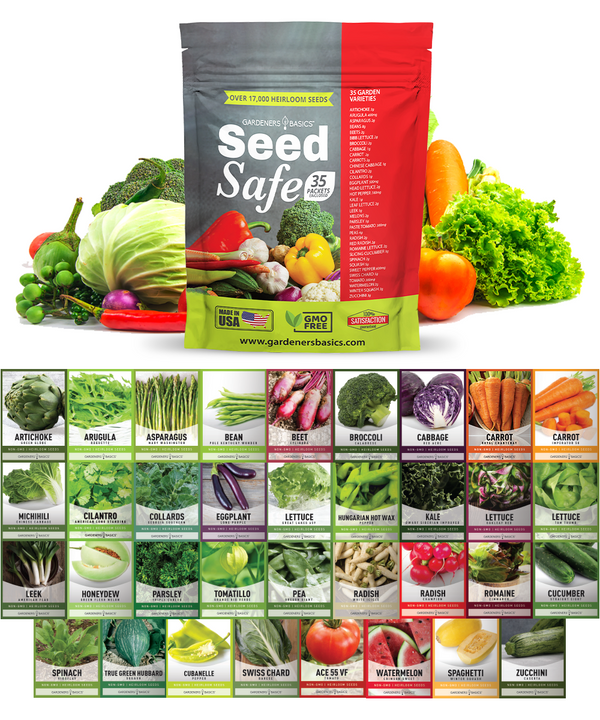
$29.95
$49.95
Seed Safe Survival Seed Kit: The Ultimate Heirloom Collection for Self-Sufficient Gardening Introducing the Seed Safe - 35 Varieties of Heirloom Vegetable, Herb, and Fruit Seeds, the ultimate solution for gardeners who want to secure a bountiful future harvest. This… read more
26 Best Survival Garden Plants and Vegetables to Include in a Survival Garden Plan
-
Potatoes: A versatile and calorie-dense crop, potatoes are a survival garden staple. They're high in carbohydrates, fiber, and essential vitamins and minerals, such as vitamin C and potassium. Potatoes are also easy to grow and store, making them a reliable food source year-round.
-
Sweet Potatoes: Rich in beta-carotene, fiber, and antioxidants, sweet potatoes are a highly nutritious crop. They're also low in calories and adaptable to various climates and soil conditions. Sweet potatoes thrive in warm conditions and can be stored for extended periods.
-
Kale: As a nutrient powerhouse, kale contains vitamins A, C, and K, calcium, and antioxidants. It's cold-tolerant and can be harvested throughout winter, providing a continuous source of fresh greens.
-
Spinach: Another leafy green rich in nutrients, spinach is an excellent source of iron, calcium, and vitamins A, C, and K. It's a fast-growing, cool-season crop that can be planted in spring or fall, offering multiple harvests throughout the year.
-
Corn: A high-calorie crop rich in carbohydrates and fiber, corn is an energy-dense food source. It can be ground into flour, cornmeal, or eaten fresh off the cob. Corn also acts as a natural trellis for beans in the Three Sisters planting method. Just remember that corn needs 4 rows of corn seeds planted to get well pollinated by wind and pollinators.
-
Beans: Beans provide a significant source of plant-based protein, fiber, essential iron, and potassium. They come in various types, including bush, pole, and dry beans. Beans are an integral component of the Three Sisters planting method and can fix nitrogen in the soil, benefiting surrounding plants.
-
Squash: Both summer and winter squash varieties are valuable additions to a survival garden. They're high in vitamins A and C, fiber, and antioxidants. Squash plants are also productive, often yielding an abundant harvest. In the Three Sisters planting method, squash is a natural mulch, suppressing weeds and retaining moisture. Everyone also knows how prolific zucchini can grow. Making sure to have some prolific growing fruits and vegetables is a great way to ensure you have plenty of food to eat when times are scarce.
-
Tomatoes: Rich in vitamins A and C, potassium, and lycopene, tomatoes are a nutritious and versatile crop. They come in various sizes, shapes, and flavors, making them suitable for sauces, salads, and canning. Tomatoes can be grown in the ground or containers and require support, such as stakes or cages. One tomato plant also produces many tomatoes to help bulk up your diet and help provide a lot of food.
-
Peppers: Peppers, both sweet and hot varieties, are a valuable survival garden addition. They're high in vitamins A, C, and E and capsaicin, which has anti-inflammatory and pain-relieving properties. Peppers can be eaten fresh, dried, or canned, providing a versatile food source. The great thing about peppers is you can get sweet peppers, mildly spicy, and very spicy peppers, which would help add lots of flavor to your meals.
-
Carrots: Carrots are rich in beta-carotene, fiber, and essential vitamins and minerals. They're a cool-season crop that can be grown in the spring and fall. Carrots store well, making them a reliable food source throughout the year. Carrots can even be left in the ground over the winter as a type of storage per se. Then you can harvest the carrots as needed during the winter months. Carrots can also be stored in wet sand for the winter.
-
Onions: Onions are an excellent vitamin C, fiber, and antioxidant source. They're versatile in the kitchen and can be eaten raw, cooked, or used as a flavor enhancer in various dishes. Onions can also be stored for months, providing a stable food source. You can also grow green onions indoors to have fresh green onions year-round. While I know not everyone loves onions, I'm not sure I could live without onions. They go into most of the dishes I make!
-
Garlic: Garlic is a flavorful addition to your survival garden and provides health benefits thanks to its antimicrobial and antioxidant properties. Garlic can be planted in the fall for a summer harvest and stores well.
-
Lettuce: Lettuce is a fast-growing, cool-season crop rich in vitamins A and K. There are various types of lettuce, including leaf, romaine, and butterhead, offering a variety of textures and flavors. Lettuce can be harvested multiple times throughout the growing season. Lettuce can be grown as a head of lettuce, or you can plant rows of many seeds and harvest the leaves. Then it will regrow, and you can keep harvesting until it bolts. Lettuce is a staple as you get thousands of lettuce seeds in our packets, enough to get you through a couple years! Lettuce can also quickly be grown indoors if needed during the winter.
-
Peas: Peas are an excellent source of plant-based protein, fiber, and essential vitamins and minerals. They're a cool-season crop that can be grown in the spring and fall. Peas can be eaten fresh, frozen, or dried, providing a versatile food source. Peas can generally be planted twice a year. They make a great spring and fall/winter crop.
-
Cabbage: Cabbage is high in vitamins C and K, fiber, and antioxidants. It's a cool-season crop that stores well, making it an ideal addition to a survival garden. Cabbage can be eaten raw in salads, cooked, or fermented into sauerkraut.
-
Beets: Beets are a nutrient-dense root vegetable high in fiber, vitamins, and minerals. Both the roots and greens are edible, offering two food sources in one plant. Beets can be eaten fresh, canned, or pickled and stored well. Beets can also be grown more than once during a growing season, so ensure you have many beets on hand.
-
Swiss Chard: Swiss chard is a leafy green vegetable high in vitamins A, C, and K, as well as magnesium and potassium. It's a fast-growing, heat-tolerant crop that can be harvested multiple times throughout the growing season.
-
Broccoli: Broccoli is a nutrient-rich vegetable that's high in vitamins A, C, and K, as well as fiber and antioxidants. It's a cool-season crop that can be planted in the spring and fall for multiple harvests. Broccoli can be eaten fresh, steamed, or frozen for later use.
-
Cauliflower: Cauliflower is another nutrient-dense cruciferous vegetable, high in vitamins C and K, fiber, and antioxidants. Like broccoli, it's a cool-season crop and can be planted in the spring and fall. Cauliflower can be eaten raw, cooked, or used as a low-carb rice substitute.
-
Radishes: Radishes are a fast-growing, cool-season crop rich in vitamin C and fiber. They're available in various colors, shapes, and flavors, making them a versatile addition to your survival garden. Radishes can be eaten raw in salads, pickled, or cooked in various dishes. Radishes are my first pick for a survival garden, actually. They can mature in 2-3 weeks, and you can keep planting them for more harvests. Make sure radishes are a staple in your survival bugout seed bag.
-
Turnips: Turnips are a dual-purpose crop, providing both nutritious roots and greens. They're high in vitamins A, C, and K and essential minerals. Turnips are a cool-season crop that stores well, offering a reliable food source throughout the year.
-
Parsnips: Parsnips are a root vegetable similar to carrots but with a sweeter, nuttier flavor. They're rich in vitamins C and K, fiber, and essential minerals. Parsnips are a cool-season crop that can be eaten fresh, roasted, or used in soups and stews.
-
Cucumbers: Cucumbers are a refreshing, hydrating crop high in vitamin K and essential minerals. They're a warm-season crop that can be grown on the ground or trellised to save space. Cucumbers can be eaten fresh, pickled, or in salads and sandwiches. Cucumbers can also be a fairly prolific producer, and you can get many cucumbers off of just one plant.
-
Zucchini: Zucchini is a prolific, warm-season crop rich in vitamins A and C, fiber, and essential minerals. It can be eaten fresh, grilled, or used in various dishes like zucchini bread or stuffed zucchini boats. Zucchini plants can produce a bountiful harvest, making them an excellent choice for a survival garden.
-
Basil: As an aromatic herb, basil is a versatile addition to your survival garden. It's high in vitamins A and K, as well as antioxidants. Basil can be used fresh in salads, made into pesto, or dried for later use. Basil plants can also help repel pests, such as mosquitoes and tomato hornworms, making them beneficial companion plants.
- Herbs: Herbs have many medicinal values that could be beneficial in times of need or emergencies and provide flavor to what could otherwise be band dishes.
Popular Herb Seeds for Planting | 35 Variety Pack
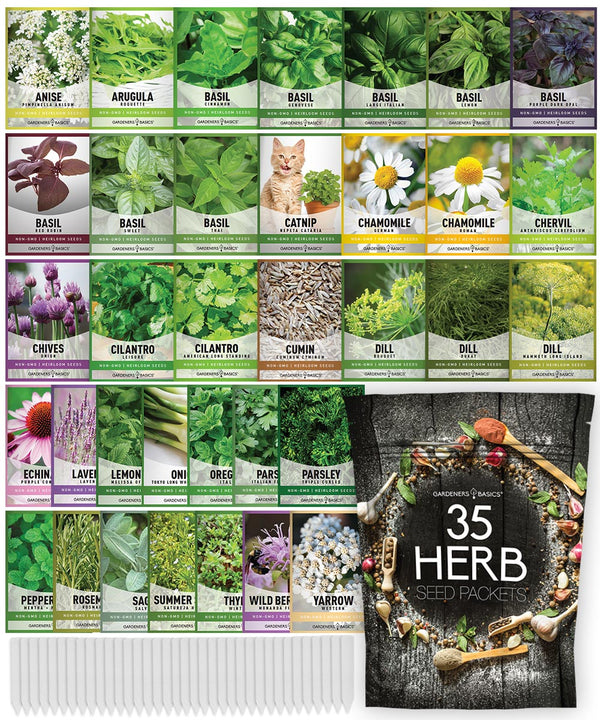
$29.95
$49.95
Heirloom, non-GMO herb seeds for indoor and outdoor home gardens! Introducing our 35 Herb Seeds Variety Pack, the ultimate selection for any herb garden enthusiast! This premium assortment includes heirloom herb seeds that are non-hybrid, open-pollinated, and non-GMO, ensuring you get only… read more
Growing and Maintaining Your Survival Garden
Growing and maintaining a survival garden requires consistent attention and care to ensure productivity and sustainability. Follow these essential tips for a thriving garden:
- Soil preparation: Starts by improving soil quality by adding organic matter, such as compost or well-rotted manure, to boost fertility and promote healthy plant growth.
- Watering: Implement efficient watering practices, like drip irrigation or rainwater harvesting, to conserve water resources and maintain optimal soil moisture.
- Pest control: Employ natural pest control methods, such as companion planting and crop rotation, to deter pests and maintain a balanced garden ecosystem. Introduce beneficial insects like ladybugs and lacewings to control pest populations.
- Weeding: Regularly remove weeds that compete with your crops for nutrients, water, and sunlight. Using mulch can help suppress weed growth and retain soil moisture.
- Fertilization: Feed your plants with organic fertilizers, such as compost tea or fish emulsion, to maintain optimal nutrient levels and support robust growth.
- Pruning and training: Prune and train your plants to encourage healthy growth, improve air circulation, and facilitate easier harvesting.
By dedicating time and effort to proper growing and maintenance practices, you can cultivate a thriving survival garden that provides a reliable and sustainable food source for you and your family.
Pest Control and Harvesting For a Survival Garden
Protect your survival garden from pests using organic pest control methods. Introduce beneficial insects, like ladybugs and lacewings, to help control harmful pests. Alternatively, you can set up physical barriers, such as row covers or insect netting, to keep pests at bay. Avoid using harsh chemicals, as they can harm the environment and reduce the overall health of your garden.
Knowing when and how to harvest each crop is essential for maximizing your garden's productivity. Research the proper harvesting techniques for each plant to ensure you collect the produce at its peak. Once harvested, store your bounty using canning, freezing, or dehydration methods g to preserve its freshness and nutritional value for future consumption. It'sessentialt to also have these items on hand for times of an emergency as you may not be able to quickly obtain them during emergencies.
Common Mistakes and Solutions
Like any gardening endeavor, survival gardening comes with its share of potential challengesLearninging about common mistakes and solutions can set your garden up for success. Encourage pollinators by planting flowers that attract bees and other beneficial insects. Practice crop rotation to prevent soil depletion and disease buildup. Regularly test and amend your soil to maintain its health and fertility.
Adapt to any challenge by adjusting your planting methods, utilizing vertical gardening techniques, or networking with local gardening communities. Sharing tips, tricks, and resources with fellow gardeners can prove incredibly helpful as you navigate the world of survival gardening.

 FAQ Section Survival Gardening
FAQ Section Survival Gardening
-
Q: What is a survival garden?
- A: A survival garden is a carefully planned garden that focuses on growing nutrient-dense, high-calorie, and easy-to-store crops. Its primary purpose is to provide a reliable and sustainable food source in times of crisis or food scarcity.
-
Q: Which crops should I prioritize in my survival garden?
- A: Focus on nutrient-dense vegetables (e.g., kale, spinach), high-calorie crops (e.g., potatoes, corn), and herbs (e.g., basil) that can be easily stored and provide essential nutrients.
-
Q: How can I maximize my survival garden's yield?
- A: Utilize companion planting techniques, such as the Three Sisters method, to promote crop growth and productivity. Opt for heirloom seeds to ensure genetic diversity and hardiness, and practice crop rotation to maintain soil fertility.
-
Q: How do I store my survival garden produce for long-term use?
- A: There are various methods for storing your produce, such as canning, drying, freezing, and fermenting. Choose the most suitable method based on the type of crop and your storage facilities.
-
Q: Can I grow a survival garden in a small space or urban environment?
- A: Yes, you can grow a survival garden in a small space by using raised beds, containers, and vertical gardening techniques. Choose crops well-suited for limited space, such as dwarf or bush varieties, and prioritize plants that yield high returns per square foot.
-
Q: Can I use natural pest control methods in my survival garden?
- A: Employ companion planting techniques to attract beneficial insects and repel pests. Introduce plants with strong sauces, like basil or marigolds, to deter pests. Practice crop rotation to prevent pest populations from becoming established and maintain a diverse garden ecosystem to promote natural pest control.
Wildflower, Perennial, & Annual Flower Seed Kit | 35 Variety Pack
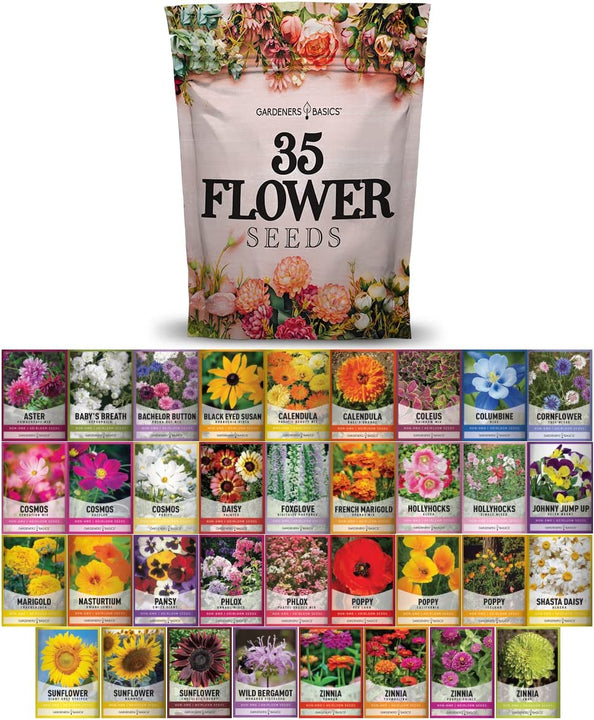
$29.95
$49.95
35 Flower Seeds Variety Pack – Heirloom, Non-Hybrid, Non-GMO, Open-Pollinated – Perfect for Pollinator-Friendly Gardens Transform your garden with our 35 Flower Seeds Variety Pack, offering a stunning and diverse selection of heirloom, non-hybrid, and non-GMO seeds. Each variety in… read more
-
Q: How can I ensure my survival garden is sustainable and environmentally friendly?
- A: To maintain soil fertility, implement organic gardening practices, such as ng compost and organic fertilizers. Practice crop rotation, cover cropping, and mulching to prevent soil erosion and promote soil health. Use water-saving techniques like drip irrigation or rainwater harvesting, and choose drought-tolerant crops to conserve water resources.
-
Q: Can I grow a survival garden if I'm new to gardening?
- A: Yes, a survival garden is achievable even for beginners. Start by choosing easy-to-grow crops that are well-suited to your region and climate. Gain knowledge about the specific needs of each plant, and utilize local resources and gardening communities for advice and support.
-
Q: What are the benefits of having a survival garden?
- A: A survival garden provides a reliable and sustainable food source during times of crisis or food scarcity. It also promotes self-sufficiency, reduces reliance on commercial food systems, and can save money on grocery bills. Additionally, gardening is a healthy and rewarding activity that can improve physical and mental well-being.
-
Q: How do I plan and design my survival garden?
- A: Assess your available space and determine the best layout for your garden, considering factors like sun exposure, soil quality, and water access. Choose crops that meet your nutritional needs and are well-suited to your region and climate. Incorporate companion planting techniques and plan crop rotation to ensure long-term productivity and soil health.
-
Q: Can I grow a survival garden year-round?
- A: Depending on your climate, you may be able to grow a survival garden year-rounConsiderider using season extenders like cold frames, greenhouses, or hoop house cold frames to protect your crops from frost. Plan your planting schedule to include cool-season crops for early spring and for and warm-season crops for the summer months.
-
Q: What tools and supplies do I need to start my survival garden?
- A: Essential tools for starting a survival garden include a shovel, rake, hoe, hand trowel, pruner, and a watering can or hose. You'll also need seeds or seedlings, compost or organic fertilizers, mulch, containers, or raised beds if gardening in a limited space.
-
Q: Should I use heirloom or hybrid seeds in my survival garden?
- A: Heirloom seeds are generally preferred for survival gardens due to their genetic diversity, adaptability, and ability to produce seeds that can be saved for future planting. However, certain hybrid varieties may offer disease resistance or higher yields, so it's essential to carefully consider the specific needs of your garden.
-
Q: Can I grow fruit trees in my survival garden?
- A: Fruit trees can be a valuable addition to a survival garden, providing a long-term, renewable source of fresh fruit. Choose fruit tree varieties suited to your climate and available space, and consider planting dwarf or semi-dwarf varieties for easier maintenance and harvest. Remember, if that is part of your plant, it must be planted before you need them, as it takes 2-3 years to have fruit.
-
Q: How can I improve the soil quality in my survival garden?
- A: Regularly add organic matter, such as compost or well-rotted manure, to your soil to improve its structure, fertility, and water retention. Practice crop rotation and cover cropping to prevent soil depletion and maintain a healthy ecosystem. Test your soil periodically to monitor nutrient levels and make any necessary adjustments.
-
Q: Can I grow medicinal plants in my survival garden?
- A: Yes, incorporating medicinal plants into your survival garden can provide a natural source of remedies for common ailments. Some popular medicinal plants include chamomile, echinacea, calendula, and lavender. Research each plant's specific properties and uses, and ensure you know about safe and effective preparation methods.
Conclusion
Survival gardening is rewarding and practical, empowering you to become self-sufficient while enjoying fresh, healthy produce as well as same some hard-earned money. You'll be well on your way to a bountiful harvest through careful planning, selecting essential crops, and maintaining your garden. Don't be discouraged by initial challenges; continue learning, experimenting, and growing. Your thriving survival garden awaits!



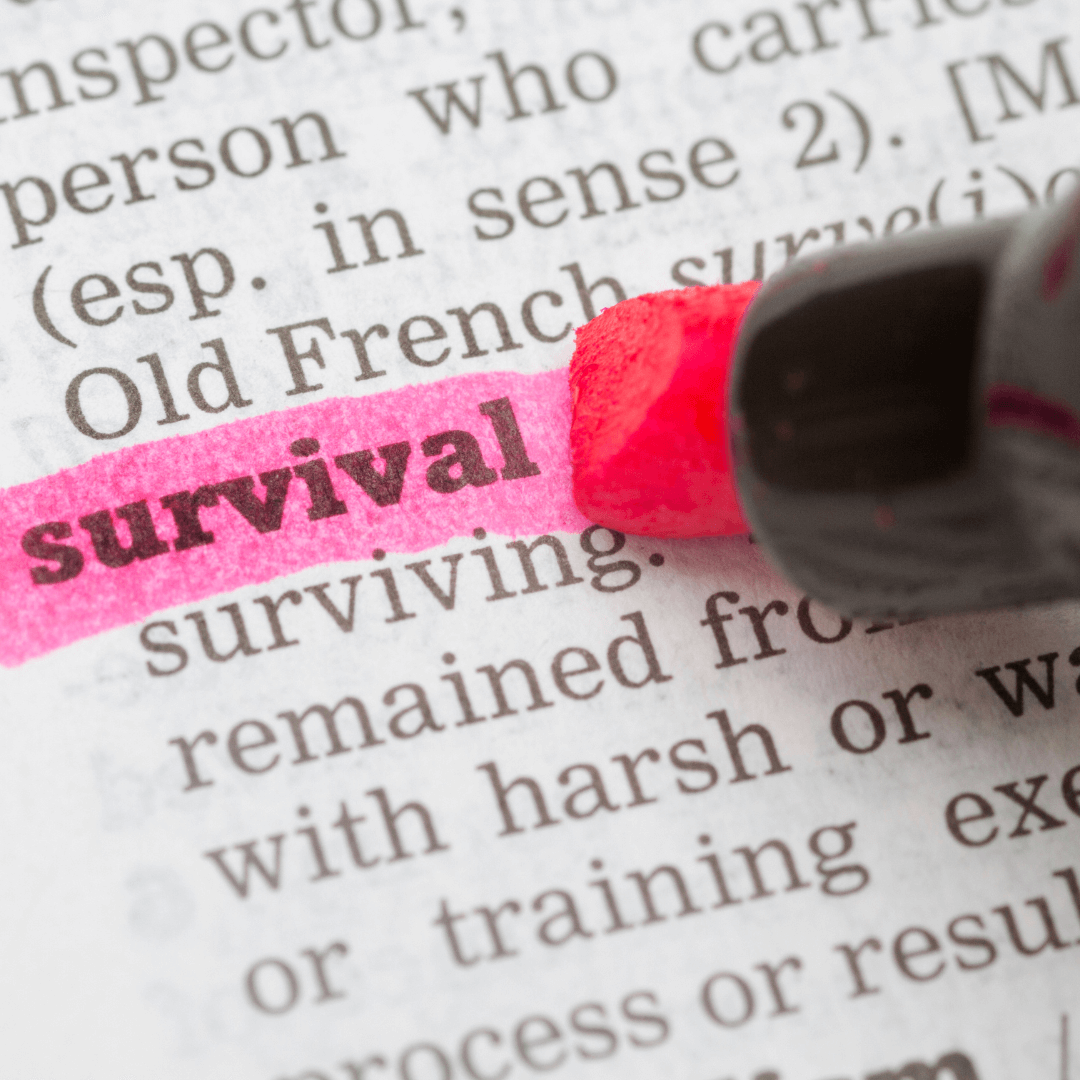

 FAQ Section Survival Gardening
FAQ Section Survival Gardening

